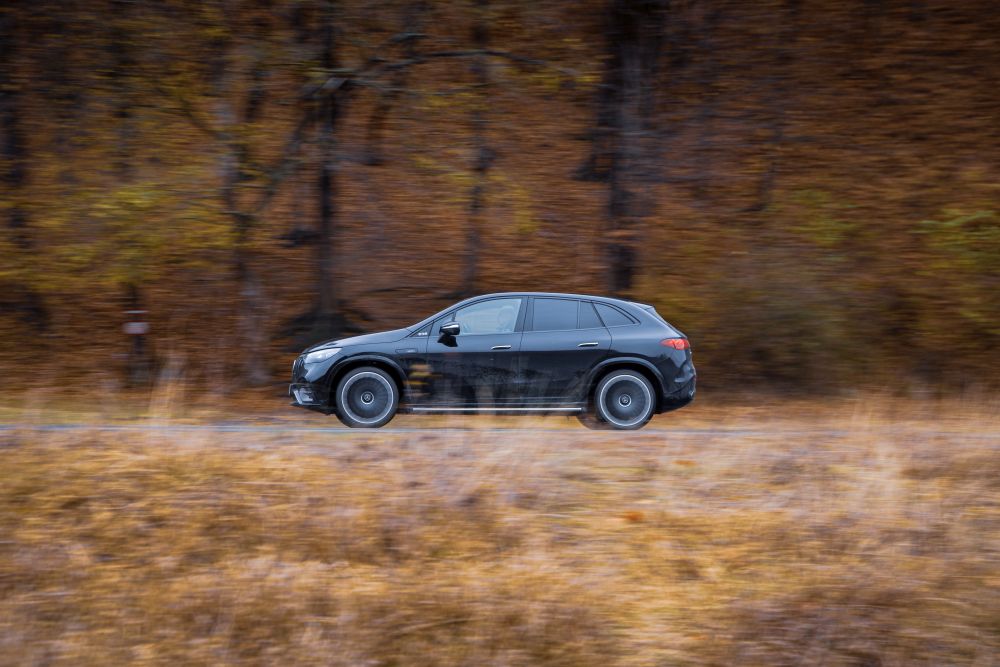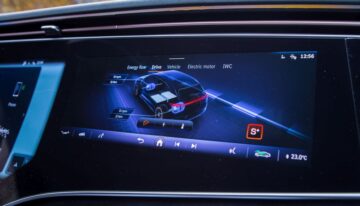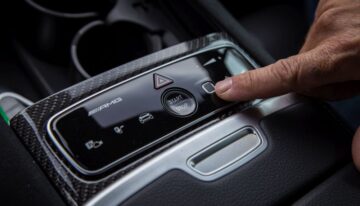The Mercedes EQE SUV promises to be more agile and exhilarating to drive than its big brother EQS SUV. Being more compact and lighter, Mercedes has even developed AMG versions based on the EQE SUV. We tested the entry-level AMG version, Mercedes-AMG EQE 43 4Matic with two motors, 476 PS and 858 Nm.
Foto: Adrian Barbu
With the Mercedes EQE SUV, Mercedes’ electric luxury range is complete: two limousines, EQE and EQS, and two SUVs, EQE SUV and EQS SUV, all built on the EVA II platform with 400V technology, adaptive air suspension, integral steering, and batteries with a net capacity of 90.6 kWh or 108.4 kWh. After driving the Mercedes EQS SUV in the top version 580 4Matic, we tested the new Mercedes EQE SUV in the entry-level AMG version with 476 PS and 858 Nm.
Mercedes only offers AMG versions for the EQE SUV, not the EQS SUV, probably because the EQE SUV is too heavy and a sporty version would not suit the character of the EQS SUV. Instead, the EQS SUV has an ultra-luxurious Maybach version. For the EQE SUV, Mercedes offers six versions, two of which are AMG: the AMG EQE 43 4Matic and the AMG EQE 53 4Matic.
To keep its distance from the more luxurious EQS SUV, the EQE SUV has a smaller battery, consisting of 10 modules compared to 12 in the EQS SUV, with a smaller net capacity of 90.6 kWh compared to 108.4 kWh in its larger sibling. However, Mercedes promises a WLTP range of 469 km.

More agile than the EQS SUV
With a curb weight of 2,600 kg, the AMG EQE 43 4Matic is 210 kg lighter than the big EQS 580 4Matic SUV, but the weight is still very high. Mercedes has called on all its technological arsenal to mitigate the effect of the enormous weight for a sports model like the AMG, be it SUV. The Mercedes-AMG EQE 43 4Matic uses an adaptive air suspension with two pressure limiting valves, one for the rebound phase and one for the compression phase, controlled independently, and features integral steering with a steering angle of up to 9 degrees that’s visible when you turn the wheels in place. Active stabilizer bars are reserved only for the AMG top 53 4Matic version in conjunction with the AMG Dynamic Plus package. Also, the rear axle carrier is connected to the bodyshell with 50% stiffer bearings.
In Sport and Sport+ modes, the suspension automatically lowers 15 mm from a standing start, while in Comfort mode, it lowers 15 mm at over 120 kph and returns to its original level below 80 kph. With optional 22-inch wheels, shod with extra-low profile 275/35 R22 tires, the AMG EQE SUV runs calm, quiet, and very confident at motorway speeds.
On long motorway journeys at steady speeds, you can switch to Slippery mode even if it’s not wet or the road is not slippery because the power is reduced by half (175 kW), and you save energy. Incidentally, even on Comfort mode, you only get 85% of the power (300 kW), with only Sport and Sport+ delivering the full 350 kW. There is no obvious difference in power feeling between Comfort and Sport/Sport+ but only between Slippery and the other modes.
Unlike the EQS limousine at the time of its initial sales launch, because it too has been modified, the two motors do not run permanently. Under normal conditions, only the rear motor works, and only when you press the accelerator harder or when the road surface is slippery does the second motor kick in, and you can see this on the very good graphics of the AMG-specific MBUX multimedia system. It’s the first electric model where you can see the current intensity, speed, and temperature of each motor, as well as the battery temperature displayed on superb graphics.

Top class comfort
Compared to the EQS SUV, which leans quite a bit in corners, the EQE SUV has better control of its body movements and offers a better compromise. This is indeed an AMG model compared to the EQS 580 4Matic SUV, but the AMG EQE 43 4Matic SUV not only leans less in corners but also offers very good ride comfort in Comfort mode. In addition, the car feels more agile, more connected with the driver, and easier to control than its big brother.
The integral steering is sufficiently heavy even in Comfort mode and offers decent feedback. At 4,879 mm long (almost 25 cm shorter than the EQS SUV) and 1,672 mm tall, almost 13 cm less tall than the GLE, the AMG EQE 43 4Matic feels much more compact than it is. When you look from the side, it looks like a slightly larger EQA and not a more compact derivative of the EQS SUV.
Poor brake-pedal dosage
Everything is perfect until you get to the brakes, but not because of the braking distances. The AMG EQE 43 4Matic brakes decisively and stops from 100 kph (62 mph) in less than 34 meters, a benchmark in the field. The problem comes in the brake pedal dosage, also found in the other models in the luxury EQ range as the pedal travel is not linear and confusing at times.
The two motors deliver performance well beyond what you’d normally need. Because of the high weight, acceleration doesn’t feel violent but if you look at the figures you’ll still see that it gets to 100 kph (62 mph) in just 4.3 seconds. Acceleration is smooth and consistent even after pushing the pedal several times.
It handles like a compact model in town thanks to a turning circle of just 10.4 meters, 50 cm smaller than a compact model like the Golf. At speeds of up to 60 kph, the rear wheels turn in the opposite direction to the front, and the EQE SUV turns very short. You can turn it around in one move on two-lane roads and squeeze into the tightest parking spaces.
On our 350 km journey, we drove in Comfort most of the time, and just a few miles in Sport and Sport+ modes on a windy road with a consumption of 25 kWh/100km. Making a simple calculation results in a range of 360 km, far from the 469 km WLTP promised range, taking into consideration that we drove over 90% of the time in Comfort mode. Fortunately, it charges relatively quickly, with up to 170 kW from DC stations and up to 11 kW from AC (optional 22 kW for 785.40 euros). But 360 km for a gran tourer like this, ideal for the highway, is quite a bit less. The base 4Matic version, the 350, promises a WLTP range of 539 km.

Superb driving position, lots of options as standard equipment
The interior enjoys the inimitable AMG ambiance with AMG sports seats, red seatbelts, and specific menus in the MBUX multimedia system and on the digital instrument cluster with specific Supersport and Track Pace modes. The driving position is low and sporty, and that’s why you sit better in the EQE SUV than in the BMW iX in which you stay too high.
There’s decent room in the rear, but the cushion is rather short for a luxury SUV, be it electric. In a desire to boost sales that aren’t up to expectations, Mercedes is offering more optional equipment as standard, so in addition to the AMG Interior and Exterior packages, the sensational Hyperscreen display, which otherwise costs 8,500 euro, is standard, as is the AMG Premium package that includes keyless entry, the Assistance Plus package, panoramic sunroof, active ambient lighting linked to assistance systems, augmented reality for navigation but also Burmester 3D audio, digital headlights, 21-inch wheels and metallic paint. But even so, the access ticket is very expensive, with a price tag of almost 125,000 euro.
Verdict
Mercedes-AMG EQE 43 4Matic offers a better compromise between comfort and handling than its big brother. It has plenty of power and is pleasant to drive despite its weight. It has a luxurious interior, a top-notch multimedia system, and more attractive standard equipment, with a lot of high-tech and comfort options included for free. But the range is relatively short for a grand tourer, and Mercedes hasn’t solved the problem with the linearity of the brake pedal.
| Technical data | Mercedes-AMG EQE 43 4Matic |
|---|---|
| Engine | 2, electric |
| Max. Output (kW/HP) | 350 (476) |
| Max. torque (Nm) | 858 |
| Battery capacity net (kWh) | 90.6 |
| L x w x h (mm) | 4,879 x 1,931 x 1,672 |
| Wheelbase (mm) | 3,030 |
| Boot Volume (l) | 520-1,675 |
| Kerbweight (kg) | 2,600 |
| Acc. 0-100 kph (s) | 4.3 |
| Top speed (kph) | 210 |
| Energy consumption (kWh/100 km) | 22 |
| Range WLTP (km) | 439 |
| Price (euro with VAT) | 124,920 |





































